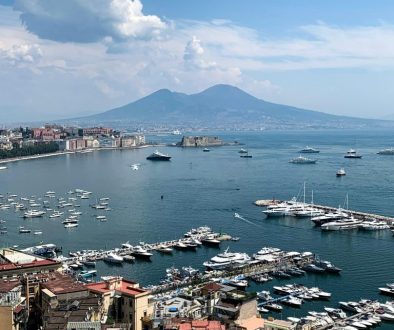Historic Centre of Naples: A Journey Through Time and Culture
Naples, one of the most captivating cities in Europe, is a place steeped in nearly 3000 years of history. Founded by the Greeks in the 8th century BC under the name Parthenope, Naples has witnessed numerous changes and dominations that have contributed to shaping its unique identity. From the Greeks to the Romans, from the Byzantines to the Normans, and from the Angevin to the Aragonese, each civilization that has passed through this city has left an indelible mark, creating a rich blend of cultures, traditions, and influences. This incredible heritage is particularly evident in the historic centre of Naples, where centuries of history come to life in its streets, squares, and architectural wonders.
3D reconstruction of ancient Neapolis.

https://commons.wikimedia.org/w/index.php?curid=95992763
Over the centuries, Naples has played a crucial role not only in Italy but across Europe. During the Roman period, the city became one of the most important centers in the Mediterranean, a hub for culture, commerce, and power. In the Middle Ages, Naples became the capital of the Kingdom of Naples, continuing to thrive thanks to its strategic location in the heart of the Mediterranean. During the Renaissance and Baroque periods, the city experienced a flourishing of art and culture, becoming a center of architectural and musical excellence.
Today, Naples is a city that masterfully blends ancient history with modern life. Its crowded streets, vibrant markets, imposing monuments, and exquisite cuisine tell stories of a past filled with glory and challenges. While the city has faced economic and social difficulties, its essence remains intact, and every corner is a window into centuries of history and culture. Naples is not just a tourist destination, but a city that invites visitors to experience its history firsthand, to feel it in its historic squares, monumental churches, museums, and distinctive streets.
Discovering Naples Historic Center: A Treasure of History and Tradition

https://www.pexels.com/photo/san-francesco-di-paola-church-in-naples-in-italy-20726092/
The Historic Centre of Naples is not just a physical place, but a true immersion into the heart of the city. This area tells the extraordinary story of one of the oldest and most fascinating cities in the world, from the ancient Greek foundation of Parthenope to Roman Naples, and through the medieval, Renaissance, and Baroque periods. In 1995, the Historic Center was recognized as a UNESCO World Heritage Site, a recognition that underscores its universal importance.

In this article, we will thoroughly explore only some places, monuments, and traditions that make the Historic Centre of Naples a unique destination. From the underground Naples to grand historic palaces, monumental churches, and ancient theaters, not forgetting the daily life that has brought these places to life for centuries.
The Organization of the Historical Center of Naples: A Maze of History and Life

The Historic Centre of Naples is a complex network of narrow streets, alleys, and squares that reflect the natural topography of the land and the layout dating back to the Greek and Roman eras. The city is built on a hilly terrain, and it is this geography that has contributed to creating the urban labyrinth that represents historic Naples today. The main artery of the center is Spaccanapoli, a street that divides the city in two and follows the ancient Roman decumanus. Its name, which means “splitting Naples,” is emblematic: the street, about one kilometer long, runs through the city like a spine connecting historical landmarks.
Alongside Spaccanapoli, the two decumani — Decumano Inferiore and Decumano Maggiore — are still visible, showcasing the Roman urban planning. These streets form the true historical neighborhoods of Naples, where the past and present intertwine. It is not only a tourist site but an area where the culture, traditions, cuisine, and art of a vibrant city come alive daily.
Historic Monuments and Churches in Naples: Guardians of Art and Spirituality

In the heart of the Historic Centre of Naples, monuments and churches of international importance stand out. The Cathedral of San Gennaro is one of the most emblematic places in the city. Known for the miraculous liquefaction of the blood of Saint Gennaro, the Cathedral represents the center of Neapolitan devotion and one of the highest expressions of Gothic and Renaissance art. The chapel dedicated to the Treasury of San Gennaro houses works by artists like Caravaggio, Giotto, and Luca Giordano. Religion and art merge, creating one of the most visited churches in the world.

Next to the Duomo (Chatedral), one of Naples’ lesser-known wonders is the Church of Santa Maria Maggiore della Pietrasanta, erected between 524-532 AD. Not far away lies the Basilica of San Giovanni Maggiore, traditionally attributed to Emperor Constantine. It was built in the 4th century AD on the remains of a Roman temple commissioned by Emperor Adriano to honor his companion Antinoo after his death. It stands as one of the city’s first Catholic churches and a testament to the transition from paganism to Christianity. The temple was repurposed for the new faith, with architectural elements integrated into the Christian structure. Although altered over the centuries, the church holds unique historical importance as a symbol of the spread of Christianity in southern Italy.

https://commons.wikimedia.org/w/index.php?curid=58400498
The Church of Gesù Nuovo, with its stone fabric-like facade, is another highlight of the city center. Its Baroque architecture and the richness of its interiors are a testament to the grandeur of Naples during the Baroque period. The external façade is the most striking part of the church, made of stones sculpted into geometric shapes that create a three-dimensional effect. This contrast with its Baroque interior makes the church one of the most fascinating in the city.

https://commons.wikimedia.org/w/index.php?curid=62730182
The interior is richly decorated in Baroque style, with frescoes, stuccoes, and paintings that adorn the walls and side chapels. The church is also famous for its main altar, which houses the statue of the Infant Jesus. Originally built as a noble palace in the 15th century, it was later transformed into a church by the Jesuits in 1584. Its name, “Gesù Nuovo,” refers to its new purpose.

https://commons.wikimedia.org/w/index.php?curid=27593950
In a Naples that never fails to surprise, it is impossible not to be enchanted by the Church and the Monastery of Santa Chiara, built in the XIV century, famous for its majolica cloister that tells the beauty and spirituality of a bygone era. The Santa Chiara Monastery, which houses a museum and library, represents the heart of a Naples that knows how to blend religious history and artistic beauty.

CC BY 2.0, https://commons.wikimedia.org/w/index.php?curid=15608323
The cloister is famous for its maiolica mosaics and frescoes that adorn the walls, creating a unique atmosphere. The inner garden adds a touch of tranquility, perfect for a relaxing break. Adjacent to the Gothic church, the cloister is a must-visit place for those looking to discover the most historic and fascinating side of Naples.
Naples Undreground (Napoli Sotterranea): A Hidden World to Explore

CC BY-SA 4.0, https://commons.wikimedia.org/w/index.php?curid=62155418
Much less known but essential to understand Naples is the underground world that extends beneath the historic center. Naples Underground is a network of tunnels, caves, and ancient aqueducts that stretch under the city’s streets. Less than 10 meters below street level, you can explore the ancient Roman Theatre, the Augustan Aqueduct, and the Catacombs of San Gennaro, the burial site of many Christian martyrs.

https://commons.wikimedia.org/w/index.php?curid=55017993
The Ancient Theatre of Neapolis, also known as the Roman Theatre of Anticaglia or the Theatre of Nerone (one of the Roman emperors), dates back to the 1st century BC and was built on the site of a previous Greek structure from the 4th century BC. It was highly esteemed by emperors such as Augustus and Claudius. Tacitus, in his Annales, recounts that Nerone loved to perform in the Neapolis Theatre, a city revered by the Romans as a custodian of Greek culture. This archaeological site is a unique testament to the greatness of Naples under the Roman Empire.
Piazza Bellini, Largo Donnaregina, and Other Historic Places in Naples

CC BY-SA 2.0, https://commons.wikimedia.org/w/index.php?curid=16286642
If there’s one square ion the city center of Naples that represents the meeting of past and present in Naples, it’s Piazza Bellini. With its Bellini Theatre, an important cultural landmark, and the ruins of ancient Greek theatres, the square is the perfect place to enjoy Naples’ social life. Its beauty is enhanced by the numerous historic cafés and artisan shops that offer a taste of tradition in a city that is always on the move.

https://commons.wikimedia.org/w/index.php?curid=34991079
Another historic square in the heart of Naples is Largo Donnaregina, home to the Church of Donnaregina and the Diocesan Museum, which houses sacred art and historical artifacts of great value. Here, every corner tells a part of Naples’ long history, from its medieval origins to the flourishing of the Renaissance.
The Monumental Complex and the Girolamini Library: A Hidden Treasure of Naples

Architect Dionisio Nencioni di Bartolomeo (Florence 1559-Naples 1638)
Museum “Quadreria dei Girolamini” in Naples
Pubblico dominio, https://commons.wikimedia.org/w/index.php?curid=105457445
In the heart of Naples, overlooking Via Duomo, lies one of the city’s most fascinating cultural and religious sites: the Monumental Complex and the Girolamini Library. This extraordinary place, often less known compared to other city attractions, holds centuries of history, art, and knowledge.Founded in 1586 by the priests of the Oratory of Saint Philip Neri, the complex includes the Church of the Girolamini, two monumental cloisters, a prestigious art gallery, and, of course, the renowned library. The church’s architecture is a refined example of Neapolitan Baroque, featuring frescoes and decorations by prominent artists, including Luca Giordano and Francesco Solimena.

CC BY 2.0, https://commons.wikimedia.org/w/index.php?curid=63372674
The Girolamini Library is the oldest public library in Naples and one of the most prestigious in Italy. Its collection comprises over 159,000 volumes, including incunabula, rare manuscripts, and sixteenth-century works. Specializing in philosophy, theology, and history, this library has been a reference point for scholars and intellectuals for centuries.

https://commons.wikimedia.org/w/index.php?curid=64054007
Beyond its historical and artistic value, the complex has experienced moments of great intrigue and mystery, including the disappearance of some precious volumes and their subsequent recovery and restoration. Today, thanks to numerous conservation efforts, the site is once again open to visitors, offering tourists and history enthusiasts the chance to immerse themselves in a unique atmosphere.
Urban Life in Napoli: Between Tradition and Modernity

The Historic Center of Naples is not just a tourist destination; it is also the city’s heart, where daily life, popular traditions, and art intertwine. Neapolitan cuisine plays a fundamental role in this experience: from the famous pizza margherita to seafood and sfogliatelle, every corner of the center invites you to discover authentic flavors. As you walk through the streets, tourists come across historic taverns where you can savor a plate of Neapolitan ragù or a freshly baked baba.
Concluding the Journey through the Historic Centre of Naples
The Old Town of Naples is a treasure that goes beyond visible beauty and the history told: it is a unique and extraordinary experience that deserves to be lived. Walking through its streets, discovering its churches, monuments, and catacombs, each corner reveals a piece of its millennial soul. What we’ve explored in this article is just a small part of a vast heritage that holds countless hidden treasures and stories to tell, making every visit an endless journey.
To make the most of your time in Naples, I recommend studying and informing yourself well before you leave. Knowing the history, places, and traditions will allow you to appreciate even more the uniqueness of this city that holds over 3000 years of history, art, culture, and unique natural beauties.
Book your stay at Napoli Domus and explore the best of Naples during your vacation!




